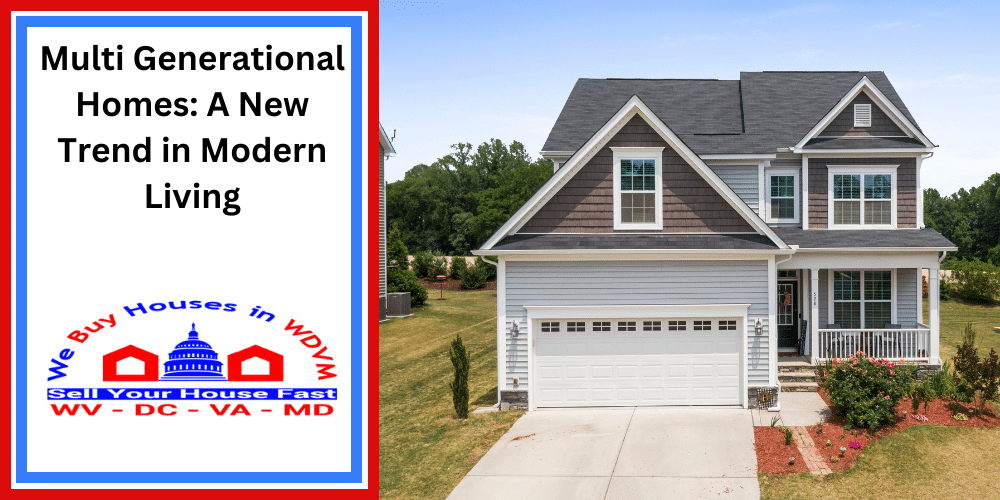Multi Generational Homes: A New Trend in Modern Living

Multi generational homes have emerged as a new trend. These unique living arrangements bring together multiple generations under one roof, creating a sense of togetherness and unity.
The idea of multi generational homes is not a new one. Throughout history, families have often lived together, sharing resources and supporting one another. However, in recent years, there has been a resurgence of interest in this type of living arrangement. With the rising cost of housing, changing family dynamics, aging parents, and a desire for closer connections, more and more families are choosing to live in multi generational homes.
One of the key benefits of multi generational homes is the opportunity for intergenerational bonding. Grandparents, parents, and children can all live together, creating a strong support system and fostering a sense of belonging. This can be particularly beneficial for older adults, who may feel isolated or lonely in traditional living arrangements. In multi generational households, they have the opportunity to interact with younger family members, share their wisdom and experiences, and feel a sense of purpose and fulfillment.
Another advantage of multi generational adaptable housing is the potential for shared expenses. By pooling resources, families can save money on housing costs, making it more affordable for everyone involved. This can be especially helpful for young adults just starting out, who may be burdened with student loan debt or struggling to find stable employment. Living in a multi generational home allows them to save money, pay off debt, and build a stronger financial foundation for their future.
In conclusion, family-oriented housing offers a unique and compelling living arrangement for families in today’s society. From fostering intergenerational bonding to providing financial benefits, these homes have the potential to enhance the overall quality of life for all family members. In the following article, we will delve deeper into the various aspects of multi generational homes, exploring topics such as design considerations, communication strategies, and the challenges and rewards of this lifestyle. Join us as we embark on this journey of discovery and learn more about the fascinating world of multi generational homes.
What Are Multi Generational Homes?
Multi generational homes, also known as multi-gen homes or multi-family homes, are residences that accommodate multiple generations living under one roof. This living arrangement has gained popularity in recent years due to various factors, including economic considerations, changing demographics, and cultural preferences.
In multi generational households, different generations, such as grandparents, parents, and children, share the same living space. This arrangement allows for closer family bonds, shared responsibilities, and mutual support. It can also provide financial benefits by pooling resources and reducing individual expenses.
These homes often feature separate living areas or suites to ensure privacy and independence for each generation. They may have multiple bedrooms, bathrooms, and even separate kitchen facilities. Some multi generational homes also include common areas where family members can gather and spend quality time together.
The reasons for choosing a multi generational home can vary. For some families, it is a cultural tradition to live together and care for aging parents. Others may opt for this arrangement to provide childcare assistance or to share the burden of household chores. Additionally, multi generational homes can offer a sense of security and companionship, especially for older adults who may feel isolated in traditional housing.
As the population ages and families face increasing financial pressures, multi generational homes are becoming a practical and appealing housing option. They promote intergenerational relationships, allow for efficient use of space and resources, and foster a sense of unity within the family.
Therefore, multi generational homes sometimes known as generational homes for boomers provide a unique living arrangement that supports the needs and desires of multiple generations. By sharing a common space, families can strengthen their bonds, save money, and create a supportive environment for all members. Whether driven by cultural traditions, financial considerations, or the desire for closer family ties, multi generational homes offer a viable solution for many families today.
Benefits of Multi Generational Homes
Adaptable housing has become increasingly popular in recent years, and for good reason. These homes, which accommodate multiple generations of a family under one roof, offer a wide range of benefits that can enhance the quality of life for everyone involved.
One of the key advantages of multi generational homes is the opportunity for increased support and care. With multiple generations living together, there is a built-in support system that can provide assistance to older family members or those with special needs. This can help reduce the need for outside assistance or costly care facilities, allowing families to save money and maintain a higher level of independence.
Another benefit is the potential for stronger family bonds. Living together allows different generations to spend more time together, fostering closer relationships and creating lasting memories. Grandparents can play an active role in their grandchildren’s lives, providing guidance and support, while younger family members can offer assistance and companionship to their elders. These intergenerational connections can lead to a greater sense of belonging and emotional well-being for everyone involved.

Multi generational households also offer financial advantages. By pooling resources, families can share the cost of mortgage payments, utilities, and other expenses, making homeownership more affordable for everyone. Additionally, sharing household chores and responsibilities can save time and energy, allowing family members to focus on other aspects of their lives.
Finally, multi generational living provides a sense of security and stability. With multiple generations living together, there is always someone around to look after the home and the family. This can provide peace of mind, especially for older family members who may have concerns about living alone.
Thus, multi generational homes offer a multitude of benefits, including increased support and care, stronger family bonds, financial advantages, and a sense of security and stability. These homes provide a unique opportunity for families to come together and create a thriving, supportive environment that benefits everyone involved.
Design Considerations for Multi Generational Homes
Multi generational homes have become increasingly popular in recent years, as families are choosing to live together under one roof. This trend has led to a need for unique design considerations to accommodate the different needs and preferences of multiple generations. In this section, we will explore some important factors to consider when designing a multi generational home.
One of the key considerations in designing a multi generational household is creating separate living spaces for each generation. This allows for privacy and independence while still promoting a sense of togetherness. Separate entrances, bedrooms, and living areas can provide the necessary space for each generation to thrive.
Another important consideration is accessibility. As the older generation may have mobility issues, it is essential to design the home with features such as ramps, wider doorways, and grab bars. Additionally, incorporating a bedroom and bathroom on the ground floor can make it easier for older family members to navigate the home.
Flexible spaces are also crucial in multi generational living. Designing rooms that can serve multiple purposes, such as a home office that can be converted into a guest room, allows for adaptability as the needs of the family change over time. Open floor plans and multipurpose furniture can also contribute to a more flexible living environment.
In terms of aesthetics, it is important to strike a balance between individual preferences and a cohesive design. Each generation may have different tastes, so finding a common ground that reflects the overall style of the home is essential. Neutral colors, timeless furniture pieces, and natural materials can create a harmonious and welcoming atmosphere for everyone.
Designing a multi generational home requires careful consideration of the unique needs and preferences of each generation. By creating separate living spaces, ensuring accessibility, incorporating flexible areas, and finding a cohesive aesthetic, families can create a home that accommodates everyone while fostering a sense of togetherness.
Financial Considerations for Multi Generational Homes
Multi generational households are becoming increasingly popular as families seek to live together under one roof. This arrangement offers many benefits, including shared expenses and a strong support system. However, before embarking on this living situation, it’s important to consider the financial implications.
One of the primary financial considerations for multi generational living is the cost of purchasing or renovating a larger property. Depending on the location and size of the home, this can be a significant investment. It’s important to carefully assess your budget and determine what you can afford.
In addition to the initial cost, there are ongoing expenses to consider. Utilities, property taxes, and maintenance costs will all increase with a larger home. It’s crucial to factor these into your budget to ensure you can comfortably afford the monthly expenses.
Another financial consideration is the potential for rental income. If you have extra space in your multi generational home, you may be able to rent it out to generate additional income. This can help offset some of the costs associated with the property.
Insurance is another important consideration. Generational homes for boomers may require different insurance policies than traditional single-family homes. It’s important to consult with an insurance agent to ensure you have the appropriate coverage for your unique living situation.
Finally, it’s important to consider the long-term financial implications of multi generational living. Will the home appreciate in value over time? Will it be easy to sell if you decide to move in the future? These are important factors to consider when making a financial decision.
In conclusion, multi generational homes offer many benefits, but it’s important to carefully consider the financial implications before making the decision to live together. By assessing your budget, considering ongoing expenses, exploring rental income opportunities, obtaining appropriate insurance, and evaluating long-term financial implications, you can make an informed decision about whether a multi generational home is right for you.
Privacy and Personal Space in Multi Generational Homes
Living in a multi generational home can be a rewarding experience, allowing families to come together and share their lives under one roof. However, it’s important to address the issue of privacy and personal space in order to maintain harmony and ensure everyone’s well-being.
In a multi generational home, it’s crucial to establish boundaries and respect each individual’s need for privacy. This can be achieved by creating designated spaces for each family member, where they can retreat and have some alone time. Whether it’s a separate bedroom, a study, or a quiet corner, having a personal space is essential for everyone’s mental and emotional well-being.
Communication is key when it comes to privacy in multi generational homes. Family members should openly discuss their needs and expectations regarding personal space. By having open and honest conversations, everyone can work together to find solutions that meet everyone’s needs. This may involve setting specific times for alone time, establishing quiet hours, or finding ways to create physical barriers for privacy.
Another important aspect of privacy in multi generational homes is respecting each other’s boundaries. This means knocking before entering someone’s room, asking for permission before borrowing personal belongings, and being mindful of noise levels. By showing respect for each other’s space, family members can coexist harmoniously and maintain a sense of privacy.
It’s also worth considering the layout and design of the home itself. Creating separate living areas or adding partitions can help to create a sense of privacy for each family unit. Additionally, soundproofing certain areas can help to reduce noise and maintain privacy.
In conclusion, privacy and personal space are essential in multi generational homes. By establishing boundaries, promoting open communication, and respecting each other’s needs, families can enjoy the benefits of living together while still maintaining their individual privacy.
Challenges of Living in Multi Generational Homes
Living in a multi generational home can bring a unique set of challenges. As families come together under one roof, there are various factors to consider that can impact the dynamics and overall experience. Understanding these challenges is essential for creating a harmonious living environment.
One of the main challenges of multi generational homes is the potential for conflicts and disagreements. With multiple generations living together, differences in opinions, values, and lifestyles can arise. Communication becomes crucial in navigating these differences and finding common ground. Open and honest discussions can help address any conflicts that may arise and promote understanding among family members.
Another challenge is the lack of privacy. In multi generational homes, personal space can be limited, and it can be challenging to find solitude or alone time. This can be particularly challenging for individuals who value their privacy or need a quiet space to work or relax. Finding ways to carve out personal space within the home becomes essential to maintain a sense of individuality and well-being.

Financial considerations are also a significant challenge in multi generational homes. Sharing expenses and managing finances can be complex, especially when multiple generations have different income levels and financial obligations. Clear communication and transparency about financial responsibilities are crucial to avoid misunderstandings and ensure fairness.
Lastly, multi generational homes can present logistical challenges. With more people living together, coordinating schedules, household chores, and daily routines can become more complicated. It requires effective planning and organization to ensure that everyone’s needs are met and that the household runs smoothly.
Living in a multi generational home can be a rewarding experience, but it is not without its challenges. By acknowledging and addressing these challenges head-on, families can create a supportive and harmonious living environment that benefits everyone involved.
Tips for Creating a Harmonious Multi Generational Home
Living in a multi generational home can be a rewarding experience, but it also comes with its challenges. To ensure harmony and a positive living environment, here are some tips to consider.
1. Communication is Key: Open and honest communication is essential in any household, but it becomes even more important in a multi generational home. Encourage family members to express their thoughts and feelings, and establish regular family meetings to address any concerns or conflicts.
2. Define Boundaries: Clearly define each person’s space and privacy within the home. This can help prevent misunderstandings and conflicts. Respect each other’s personal boundaries and establish rules that everyone agrees upon.
3. Flexibility and Compromise: Living with multiple generations means different schedules, preferences, and lifestyles. Embrace flexibility and be willing to compromise. Find solutions that accommodate everyone’s needs and create a harmonious living environment.
4. Share Responsibilities: Assigning and sharing household chores can help distribute the workload and foster a sense of unity. Create a schedule that ensures everyone contributes to the upkeep of the home. This can also teach valuable life skills to younger family members.
5. Embrace Quality Time: While it’s important to respect each other’s personal space, make an effort to spend quality time together. Plan family activities, meals, or outings that allow everyone to bond and create lasting memories.
6. Seek Support: It’s natural to encounter challenges in a multi generational home. Don’t hesitate to seek support from professionals, such as family therapists or counselors, who can provide guidance and help resolve any conflicts that may arise.
By following these tips, you can create a harmonious multi generational home where everyone feels valued and respected. Embrace the unique dynamics of your family and celebrate the benefits of living together under one roof.
Resources for Finding Multi Generational Home Plans
When it comes to finding multi generational home plans, there are several resources available to help you in your search. Whether you’re looking for a home that accommodates aging parents, adult children, or extended family members, these resources can provide you with the options you need.
One popular resource is online home plan websites. These websites offer a wide range of multi generational home plans that cater to different needs and preferences. You can browse through various designs, layouts, and features to find the perfect plan for your family. Some websites even allow you to customize the plans to suit your specific requirements.
Another valuable resource is architectural magazines and books. These publications often feature articles and profiles of homes that are designed for multiple generations. They showcase innovative designs and provide valuable insights into the planning and construction process. You can find inspiration and ideas that can help you create a functional and comfortable living space for your entire family.
Additionally, working with a professional architect or designer can be beneficial. They have the expertise and experience to create custom multi generational home plans that meet your unique needs. They can take into account factors such as accessibility, privacy, and shared spaces to create a home that works for everyone.
Lastly, attending home shows and exhibitions can be a great way to explore multi generational home plans. These events often feature builders, architects, and designers who specialize in this type of housing. You can view different floor plans, talk to experts, and gather valuable information to help you make informed decisions.
In conclusion, finding multi generational home plans doesn’t have to be a daunting task. With the right resources and guidance, you can find the perfect plan that meets the needs of your entire family. Whether you choose to explore online websites, architectural publications, work with professionals, or attend home shows, there are plenty of options available to help you create a home that promotes togetherness and comfort for generations to come.
Thank you for taking the time to read this post on multi generational homes. We hope that you have found the information provided to be insightful and valuable. Please feel free to leave any comments or feedback, as we appreciate hearing from our readers.

About Justin Mitchell
Justin, the owner and operator of “We Buy Houses In WDVM,” is a seasoned professional with a knack for providing solutions to individuals looking to sell their homes or investment properties quickly, regardless of the circumstances.
With a wealth of experience in various buying and selling scenarios, Justin excels at simplifying transactions and ensuring a stress-free process for all parties involved.
Whether you’re seeking a swift cash purchase or exploring alternative selling solutions, Justin is dedicated to finding a win-win outcome for you. As a legitimate house buyer,
Justin boasts a stellar rating on Google Reviews, a testament to his commitment to customer satisfaction.
Visit his “Beat Any Offer” page to understand why he values presenting sellers with concrete facts over mere opinions. Discover why he believes that facts matter most when it comes to creatively selling a house fast.
Table of Contents

